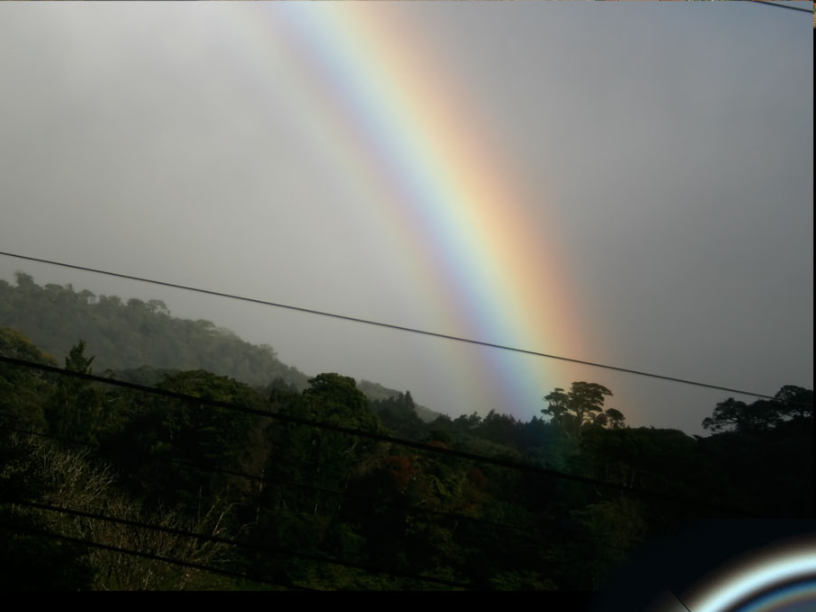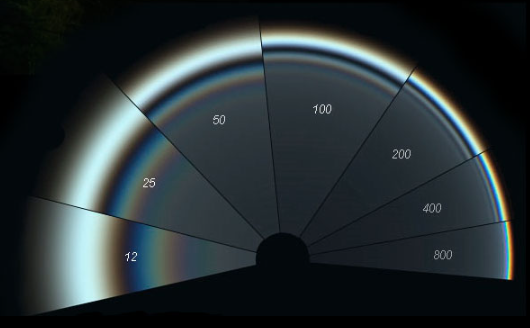OPOD - Cloud Forest Bow
OPOD - Cloud Forest Bow: A Rare and Enigmatic Atmospheric Phenomenon
Have you ever heard of the Cloud Forest Bow? This captivating optical phenomenon, captured by Alex Knopman in Monteverde, Costa Rica, is a true marvel of nature. What makes it even more intriguing is that it serves as a "missing link" between a traditional rainbow and the diffuse, almost colorless fogbow. Let's delve into the details and unravel the mysteries behind this extraordinary sight.
The Spectacular Cloud Forest Bow
The Cloud Forest Bow, unlike its more common counterparts, boasts a broader shape and less saturated colors. In fact, its center displays an intriguing band of almost pure white. Additionally, its supernumerary, the fainter bands of colors that appear on the inner side of the primary bow, are spaced farther apart than usual. This unique combination of characteristics distinguishes the Cloud Forest Bow from other atmospheric optics phenomena.
Understanding the Science
To comprehend the formation of the Cloud Forest Bow, we need to explore the properties of water droplets. Unlike raindrops, which typically exceed 1mm in diameter, the droplets responsible for creating this elusive bow are smaller, measuring less than 0.25mm in diameter. Similarly, these droplets differ from fog droplets, which are usually smaller than 0.1mm.
The primary factor influencing the appearance of the Cloud Forest Bow is diffraction. As droplet size decreases, diffraction effects become increasingly prominent. The bow broadens, losing its vivid colors and assuming a more diffuse appearance. Meanwhile, the supernumeraries retain more color and shift inward towards the primary bow.
Unveiling the Elusive
Encountering an intermediate bow like the Cloud Forest Bow is a rare occurrence, making it all the more captivating when witnessed. While it occasionally reveals itself at waterfalls and in the artificial sprays of lawn sprinklers, its appearance within the perpetual cloud hanging over Monteverde is truly remarkable.
The Role of Drop Size
The size of water droplets plays a crucial role in the formation and appearance of atmospheric optics phenomena. By studying the relationship between drop size and optical effects, we can gain valuable insights into the complexities of these natural wonders.
To illustrate this, an Airy function simulation was conducted using a lognormal drop size distribution with a standard deviation in diameter of 15% of the mean. The results indicated that uniform-sized drops would yield more supernumeraries than typically observed in nature.
Exploring Further
The Cloud Forest Bow serves as a reminder of the incredible diversity and intricacy present in atmospheric optics. By venturing into this fascinating realm, we can uncover countless other awe-inspiring phenomena that occur in our skies. From iridescent clouds to halos and arcs, the world above us holds an array of optical treasures waiting to be discovered.
Conclusion
The Cloud Forest Bow stands as a testament to the breathtaking beauty and complexity of our atmosphere. Its distinctive characteristics and rarity make it a true gem among atmospheric optics phenomena. Whether gazing upon it in Monteverde or encountering it unexpectedly elsewhere, this enigmatic bow offers a glimpse into the wonders that nature has to offer. So, keep your eyes to the sky and be ready to witness the extraordinary unfold before you.

Cloud Forest Bow, Costa Rica
Imaged at Monteverde by Alex Knopman.
�This rainbow is apparently seen EVERYDAY in Monteverde, which is famous for its cloud forests. You can see that the rainbow is just within the cloud that perpetually hangs over the area. The second pic is a close up of the same rainbow with its supernumeraries.� ©Alex knopman
Here we have a not too often seen �missing link� between a true rainbow and the diffuse and almost colourless fogbow. It is broader than a normal rainbow and its colours are less saturated. There is even a band of (almost) white along its centre. The other difference is that its supernumerary is farther spaced than usual from the main primary bow.
Water drops less than 0.25 mm diameter made it compared with raindrops (1mm dia and more) and fog droplets (less than about 0.1 mm). Diffraction has broadened the bow but to a lesser extent than occurs with the smaller droplets of fogs and mists.
These �intermediate� bows are unusual and not often seen except sometimes at waterfalls and in the artificial sprays of lawn sprinklers.

Rainbow to fogbow:
Numbers are the diameter of the water drops in micron (1/1000mm). As the drop size decreases diffraction effects are increasingly dominant. The bow broadens and loses its colours. The supernumeraries retain more colour and move inwards from the primary bow.
At right an Airy function simulation for a lognormal drop size distribution with a standard deviation in diameter of 15% of the mean. Uniform sized drops would give more supernumeraries than are customarily seen in nature.

Note: this article has been automatically converted from the old site and may not appear as intended. You can find the original article here.
Reference Atmospheric Optics
If you use any of the definitions, information, or data presented on Atmospheric Optics, please copy the link or reference below to properly credit us as the reference source. Thank you!
-
<a href="https://atoptics.co.uk/blog/opod-cloud-forest-bow/">OPOD - Cloud Forest Bow</a>
-
"OPOD - Cloud Forest Bow". Atmospheric Optics. Accessed on November 26, 2024. https://atoptics.co.uk/blog/opod-cloud-forest-bow/.
-
"OPOD - Cloud Forest Bow". Atmospheric Optics, https://atoptics.co.uk/blog/opod-cloud-forest-bow/. Accessed 26 November, 2024
-
OPOD - Cloud Forest Bow. Atmospheric Optics. Retrieved from https://atoptics.co.uk/blog/opod-cloud-forest-bow/.